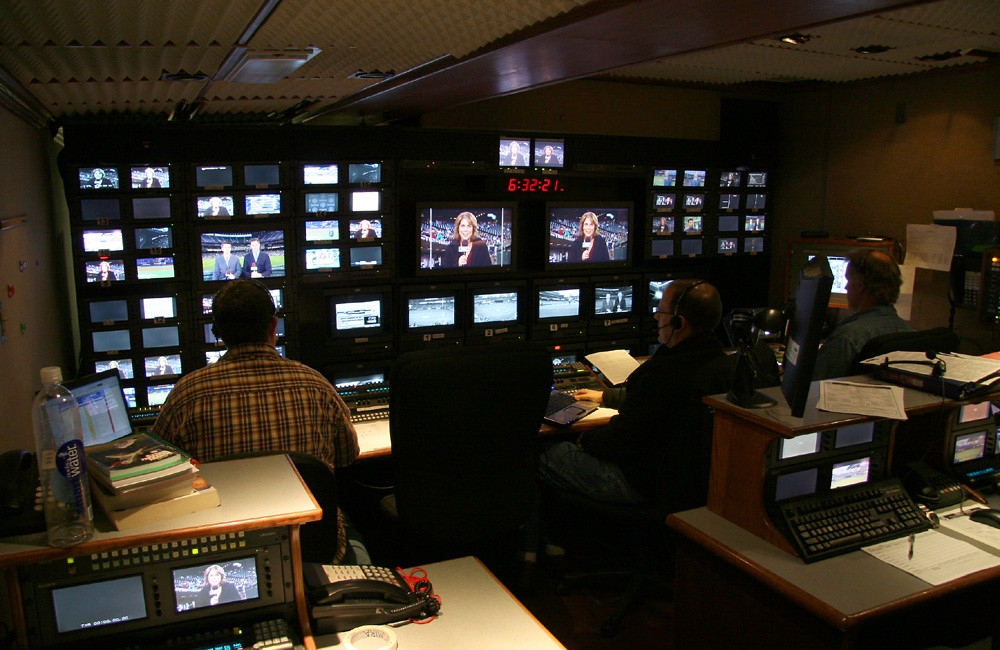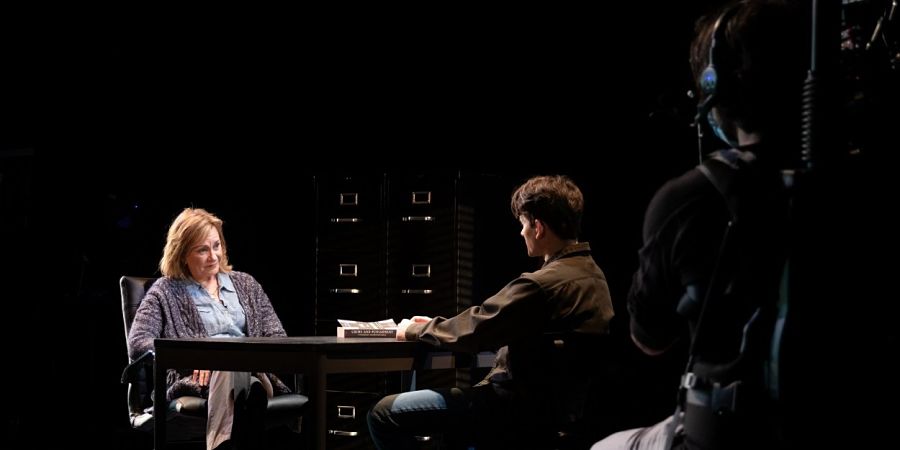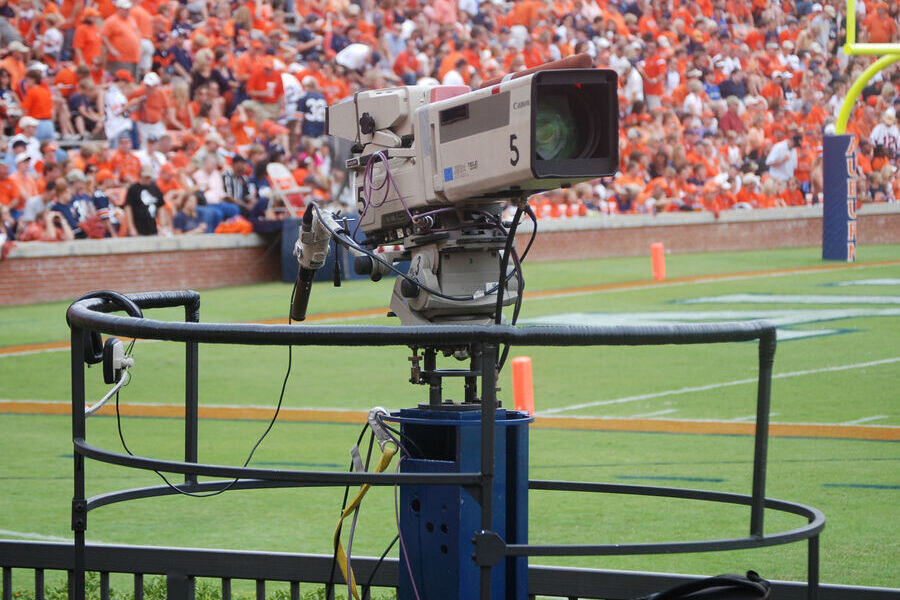I want to be a theatre fan. I say that loosely, because I don’t tend to be the kind of fanatic who collects playbills and saves ticket stubs, and my ability to recall who was in which cast of what show is utter garbage. I mean “fan” in a sense closer to the way I’m a fan of my hometown sports teams—the way in which, though I live in Chicago, I can still find ways to watch the football team I grew up watching, the one I have family memories connected to, whenever they play, no matter where in the country they’re playing. I wish I could be that kind of a fan for theatre too.
The problem is, of course, as many have noted over the pandemic, that theatre has historically been inaccessible, be that due to high ticket prices, unaccommodating situations for those with disabilities or parenting needs, or simply geographic location. When it comes to location, that range can be relatively small; I sit a mere three-hour drive from my hometown theatre, Indiana Repertory Theatre, but haven’t seen a single one of their productions for nearly a decade. I really wish I were exaggerating. Theatre, in its admirable pursuit of its core identity as a live, in-person experience, has missed out on what sports leagues around the world have known for decades: Fandom travels.
I’ve been hesitant to write this piece for a while now, as I’ve had conflicting thoughts on the parallels between theatres venturing into the digital realm, as many have been forced to do in the past year, and the sports leagues that dominate our television. And I do mean dominate: The National Football League has systematically taken over Sundays, Monday nights, Thursday nights, and even Saturdays when they deem it necessary. If you throw in college football and the occasional high school broadcast, Tuesdays and Wednesdays are really the only days where you may struggle to find a live football game to watch.
So the obvious question is: Why not theatre? What’s keeping theatre from flipping that switch, turning an eight-show, five- or six-day in-person performance week into something that is easily clicked over to on a television, except for the high holy day of Mondays off?
Thinking about this prompt, I had a conversation with the Alley Theatre’s general manager, Brandon Kahn, who happened to write his thesis at Columbia University on this very topic. Throughout our conversation, Kahn and I were in pretty steady agreement: The potential is there, but it’s going to take a lot of time, and even more buy-in and effort.
“I think certainly we can learn from the NFL,” Kahn told me in a phone interview. “It all started with the basis of live entertainment. It was about bringing people together to watch an event of some sort, and there were regular events that happened.”
Of course, the NFL, along with other major sports leagues, has had decades to reach its current level of market saturation. The first televised sporting event in the United States was in 1939, of a college baseball game, with professional football’s first broadcast coming later that same year. And many of the early fears of pro sports owners and clubs echo concerns I’ve heard around a potential theatre move to broadcasting performances live: What if people stop coming, forgoing the in-person experience for the comfort of home? After all, the argument goes, theatre, like sports, is really intended to be experienced live, to feel the exhilaration of an unexpected play surrounded by peers.
Before 1973, the NFL had rules to accommodate the live-vs.-TV fear. Blackout rules determined that games would be blacked out, meaning unavailable to watch, on TV stations within 75 miles of the team’s home city. The journey to the changing of that rule is a long one that isn’t worth recapping for our purposes here—suffice to say that at one point, it involved President Nixon’s frustration at being unable to watch Washington’s football team run to Super Bowl VII from the White House due to CBS enforcing the NFL’s blackout rules. Even the attorney general got involved in this struggle. The important takeaway is that, from 1973 to 2014, the NFL adjusted the rules, deeming that 85 percent of tickets needed to be sold 72 hours before a game in order for teams to broadcast locally, still ensuring that the local fanbase got out of their homes and into the stands. Some version of that system was in place for decades.
It’s an idea I’ve kicked around in my head. Would it even be possible for theatres to enact something similar, making any potential broadcast only available to those outside of the immediate geographical area to preserve in-person attendance? During the pandemic, some theatres did enforce geolocation restrictions on virtual productions, so it’s not entirely out of the realm of possibility (though, perhaps ironically, most of those involved limiting broadcasts to theatres’ local areas rather than letting them flow freely across the internet). But, as Kahn noted in our conversation, the fear of a decline in in-person attendance might be ill-founded. He compared it to a former concern in the industry that national tours of Broadway shows would be a detriment to turnout on Broadway. Of course that hasn’t been the case; until the pandemic lockdown, Broadway was booming. As Kahn also noted, these tours turned out to be pretty great marketing tools for the Broadway brand, and even for specific shows.

Still, as Kahn and I talked and found agreement that theatre could draw inspiration from what sports leagues have been able to build, he cautioned that adapting it to theatre will be tricky, especially when you consider all of the stakeholders involved. A primary concern Kahn noted: How would any potential broadcast deal pay playwrights, whose intellectual property could be at multiple theatres across the country during any given season? If the last year proved anything, as theatres ventured into a world more akin to film and television, it is that for anything significant to happen on this front, all the relevant unions will need to find common ground to make sure everyone is protected and getting paid fairly for their labor and the distribution of their intellectual property.
It’s a uniquely theatrical concern, the intellectual property issue of productions of the same play cropping up around the country. Games don’t get do-overs or revivals, or get licensed for future productions. And NFL owners and coaches aren’t worried about people seeing what they put on the field in front of a national audience and try to steal it. What they do protect, and have monetized, are the recordings of the game themselves. In fact it’s now such a completely normal part of the game to study filmed games that rabid fans can pay a little extra to the NFL for access to the All-22 footage (so called because it’s the one angle that shows all 22 players on the field at once throughout, as opposed to closer angles for broadcast TV; it’s also called Coaches’ Film, as it’s used by coaches to analyze past games and future opponents). While I’m not the kind of fan who’s willing to dole out for that for football, when it comes to theatre the possibility of having access to filmed theatre performances that otherwise might be lost to history, not only for fans but for those who wish to study the work of their predecessors, is very promising.
Another roadblock: Theatre has no central governing body to determine who is protected and how. The NFL is an organization that’s able to control its product in a way theatre, as an industry, can’t. LORT or even the Broadway League don’t have the power the NFL does to leverage an overall product, as opposed to individual shows. That leverage for the NFL results in lucrative television deals and ad revenue. Theatres, conversely, have been operating independently as they step gently offstage into a variety of streaming venues (BroadwayHD, Broadway on Demand, and Marquee TV, to name a few). Successful examples of filmed performance over the past few decades, which have been many folks’ first exposure to professional theatre, all had this single-company control in common, whether it was NT Live, Met Live, or Live From Lincoln Center.
This every-theatre-for-itself model has created complications. You only need to look back over the last year to see the strains it put on theatres as they attempted to create work under one contract while others were doing similar things under another. Even after Actors’ Equity Association and SAG-AFTRA reached a pandemic-only agreement, gray areas still remained. The potential of some kind of large-scale revenue model that could distribute ad revenue via TV and other streaming deals among a consortium theatres is certainly intriguing, but will take heavy reorganization (or at the very least, extensive cooperation) to begin to figure out.
In the meantime, theatres would still have other concerns. If they offer a secondary (though ideally not lesser) product, how do theatres craft a narrative that encourages people to still come to in-person productions? The aforementioned blackouts are one idea, though a not great one when you consider issues of access for local theatregoers with disabilities or child care or other needs that prevent them from being able to enjoy the in-person theatrical experience.

On a personal note, I’m willing to admit that filmed theatre, or theatre made for streaming, or streamed pro-shots or what-have-you, has been rough for me to watch. It wasn’t until I caught the Goodman’s production of The Sound Inside a few weeks back that something clicked. It wasn’t because of the play or performances per se (though no knock on either), but instead the concept behind the Goodman’s LIVE series. The series features live performances, on a stage, with multiple moving cameras controlled by a television producer, much as you would see for the broadcast of any live television show. (In my head I like to picture an animated behind-the-scenes Glenn Weiss running the 2013 Tony Awards.)
After a while, Zoom theatre started to feel like a stopgap, and productions made specifically for the digital medium began to feel like film, too easy to pause and scroll TikTok for a while (yes, even the Hamilton pro shot). And even many productions filmed in a COVID-safe way on a stage and in front of an audience made me feel like I was a secondary audience to a play meant to be seen in person. There was something about The Sound Inside putting live actors, on a stage, with all of the stagecraft we love about live theatre, but broadcast with the buzz and energy that live television can capture, where anything can happen, that pulled me back into a theatre mindset for the first time in over a year. And it was all done by a theatre company, not dolled up with superstars and massive budgets akin to the recent live broadcasts of Jesus Christ Superstar or Rent.
I’m not here to sing the praises of that Goodman production or to critique it, but to acknowledge that we are truly on the precipice of the potential of theatres delving into this medium. We’re just now starting to be able to get actors onstage together, sans plexiglass or PPE, creating the art we’ve all come to know and love in a familiar way. And yet, as season announcements continue to roll out in anticipation of a fall or winter return, it’s already to begun to feel like lessons learned over the past year are starting to fade. My biggest fear—bigger than any fear that seats in theatres won’t be filled—is that theatres will let this moment of opportunity pass by without a full exploration of the possibilities.
That would be a shame, considering that many theatre leaders were more than ready to acknowledge the expanded audience reach afforded by these streamed productions. The pitch I put on Twitter after watching The Sound Inside was that I’d love to see a theatre take its second (or third, if you’re lucky enough to have one) stage and dedicate that space to live broadcasts of plays. Perhaps one day even being able to partner with a local PBS station to offer one live broadcast a week on actual television—as opposed to broadcast live on a theatre’s website—which would be the main way the production is seen.
In my conversation with Kahn, he acknowledged that it’s not likely to be in the best interests of every theatre company to try to also become a broadcasting company. But he was also hopeful that there are tech companies out there who can step in to help, companies willing to focus on and support a specific vision of theatre’s place within the world of screens. Hopefully there are companies looking to do just that, and this too is a pitch to them. Theatres over the last year and a half have proved their ability to adjust and adapt. With In the Heights kicking off a year or more of movie musicals hitting the big screen, I wouldn’t even call this striking while the iron is hot. It feels like it’s just heating up. It may take time, and trial and error, though I hope it doesn’t take theatres decades to realize that people like me want to be fans of your work from wherever they are.
“It creates this way of having people continue to be connected to the work you’re doing,” said Kahn. “I think that we’ve taken some amazing steps in this last year to get the conversation started.”
Jerald Raymond Pierce (he/him) is associate editor of American Theatre. jpierce@tcg.org


